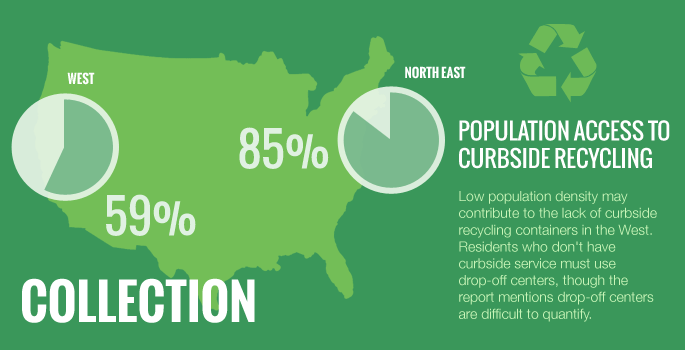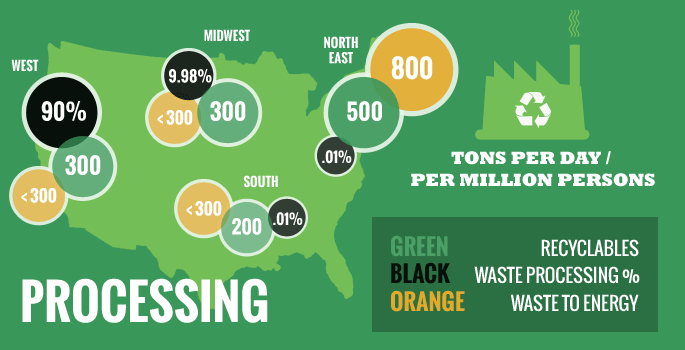Recycling is often reported in national figures but there are strong differences in each region of the country that can be caused by cultural attitudes towards recycling containers, money available for recycling programs, and local population density. A report entitled “Municipal Waste in the United States: 2011 Facts and Figures” published by the U.S. Environmental Protection Agency looked at some of these regional trends.

Three quarters of the U.S. population has access to the nearly ten thousand curbside recycling programs throughout the country. Some of these programs require residents to presort their recycling containers, though many municipalities are trying to increase participation by using single-stream recycling to simplify the process for consumers and then sorting the materials at a facility. The strong leader in curbside recycling is the Northeast where 85% of the population has access to curbside recycling, while the service is available to only 59% of the people living in the West.
Low population density may contribute to the lack of curbside recycling containers in the West. Residents who don’t have curbside service must use drop-off centers, though the report mentions drop-off centers are difficult to quantify.
Deposit systems are used to boost participation, particularly with beverage containers, and here again the Northeast is the leader. Out of ten states with deposit systems, six are in the Northeast, two are in the Midwest, and two are in the West. None of the Southern states have deposit programs.

Not surprisingly the Northeast leads in recyclables processing, with a capacity of almost 500 tons per day per million persons. The West may not have the most curbside recycling containers, but they are nearly tied for second with the Midwest in recyclables processing at over 300 tons per day per million persons. The South processes a bit over 200 tons per day per million residents. However this is only for materials recovery facilities (MRFs), many of which are dedicated to only one recyclable such as paper or plastic.
The West dominates in one area: mixed waste processing. A mixed waste plant takes a stream of waste and then sorts out the recyclables. With so few curbside recycling bins it’s not surprising that the West focuses on mixed waste, but it is a shock that nearly 90% of the mixed waste in the US is processed by facilities in the West. Most of the remaining mixed waste processing occurs in the Midwest, and virtually none is processed in the other areas of the country.
Many municipalities burn non-recyclable waste to produce energy. The Northeast converts over 800 tons of waste to energy per day per million people, while the other three areas process less than 300 tons per day per million people.
Despite the disparity, there is a strong interest in recycling across the nation. Let’s hope that all of the regions will catch up and curbside recycling containers will become common in all towns and cities in the country.
Image: http://https://www.wastewiseproductsinc.com



































































































































 Three Ways to Engage Teams and Clients to Maximize Your Recycling Program Engagement
Three Ways to Engage Teams and Clients to Maximize Your Recycling Program Engagement  How to Integrate Accessibility Into Your Sustainability Planning
How to Integrate Accessibility Into Your Sustainability Planning  Why Park Benches Can Promote Workplace Well-Being
Why Park Benches Can Promote Workplace Well-Being 

Hi – Do you have an updated version of the graphic showing WtE, landfill, and recycling? Thanks!